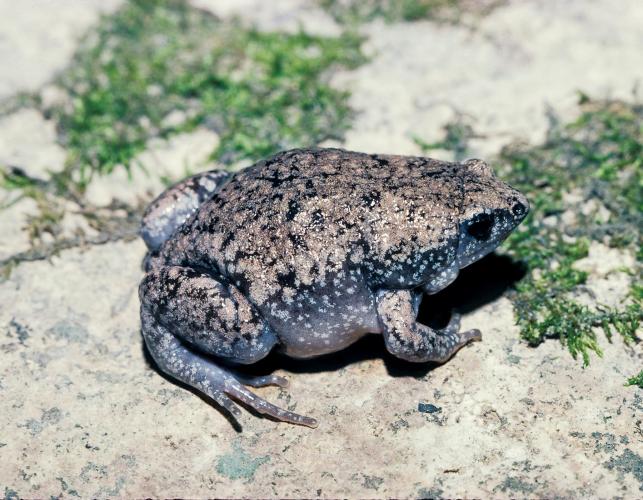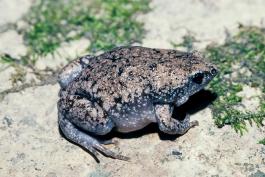
The eastern narrow-mouthed toad is a small, plump, burrowing amphibian with a distinct fold of skin behind a small, narrow, pointed head. This animal has short legs, lacks tympana (the rounded external eardrum behind each eye, common in many frogs), and lacks webbing between the toes.
The general color is tan, brown, or reddish brown. The back has a pattern that looks like a long, dark wedge pointing toward the head. This dark wedge is bordered on its sides by a wide, lighter-colored stripe. Below that is a dark stripe running from the snout to the side of the hind legs. These patterns are often obscured by numerous small dark brown or black markings. The belly is mottled with dark gray; males have deeply pigmented throats.
The call of a male eastern narrow-mouthed toad is a bleating, nasal “baaaaa”; it lasts 1–4 seconds, sounding like the bleat of a lamb. When one individual calls, it often causes other individuals to call simultaneously.
Similar species: The western narrow-mouthed toad, a close relative, has a lighter color and lacks prominent markings on the back. Also, its call is quite different, being a high-pitched, short “peep” followed by a nasal, buzzy bleat. Missouri's two narrow-mouthed toads have different distributions in the state, but the ranges do overlap in several western counties. In these counties, populations may occur in the same area. However, the calls of both species are different enough to prevent them from hybridizing.
Adult length (snout to vent): 1 to 1¼ inches, occasionally to 1½ inches.

Throughout most of the southern half of the state. It has a large range to the east and south of our state.
Habitat and Conservation
In Missouri, the eastern narrow-mouthed toad lives in a variety of habitats, including flooded swamps, open grasslands, and upland and bottomland hardwood woodlands. It spends most of its time in loose, damp soil under rocks and logs. It prefers a habitat with shelter and moist soil, usually near ponds, swamps, and streams. In the Ozarks, however, individuals do occur under flat rocks on relatively dry glades.
A eastern narrow-mouthed toad may create its own short burrow or use burrows created by other animals. It will often sit in a burrow with its head slightly visible at the surface, awaiting prey.
Food
Eastern narrow-mouthed toads mainly eat ants, but they also eat termites, small beetles, and spiders. Eastern narrow-mouthed toads have evolved a skin secretion that is noxious to many predators; the secretion also protects them from the defensive bites of ants. They typically sit on anthills while eating their preferred food.
Life Cycle
This species usually breeds in large puddles, temporary pools, fishless flooded ditches, and fields, including rice fields in southeastern Missouri. They will, however, occasionally use permanent bodies of water, especially along shallow edges with thick vegetation.
Males begin chorusing in late April, and chorusing can also take place during the summer months, especially in June or early July after heavy rains. Males usually hide under leaves or other debris at the water’s edge, or they may sit in thick vegetation within the water as they call. Special glands on the male’s belly secrete a gluey substance that sticks the mating pair together. Females can lay over 1,000 eggs in several films on the surface of the water. In Missouri, females lay an average of 510 eggs. The membrane enveloping the egg is unique to this genus: it is circular, with one or more flat surfaces, so the film of eggs resembles a mosaic pattern. The eggs hatch in fewer than 3 days. The tadpoles develop rapidly, becoming toadlets in 30–60 days. They become sexually mature in 1–2 years.
Human Connections
As predators, these amphibians help control populations of many insects that are pests to humans. Additionally, their beautiful and strange singing adds to the magic of a Missouri evening.
The genus name, Gastrophryne, means "stomach-toad." It's a great name for these pudgy-looking animals.
Ecosystem Connections
Narrow-mouthed toads are predators that help keep populations of ants and other insects in balance. Due to their specialized diet of consuming many types of ants, including exotic and invasive species, narrow-mouthed toads might benefit from these new food sources. They might also be be helpful in controlling invasive ants.
These toads, and especially their eggs, tadpoles, and young toadlets, become food for both aquatic and terrestrial predators. Their noxious skin secretion apparently helps defend them from at least some predators.
The narrow-mouthed toads (Microhylidae) are a large family of burrowing, secretive frogs. The family has representatives in Asia, Malaysia, northern Australia, New Guinea, southern Africa, Madagascar, and North and South America. The group probably originated in Asia. The family contains 63 genera with 557 species. In the United States, this group is represented by two genera and four species; of these, two species of one genus (Gastrophryne) live in Missouri. Most members of this group are fossorial (burrowing), spending most of their time in burrows or under rocks or logs. They tend to be small, plump, and squatty in appearance. All species in the United States have a characteristic fold of skin behind a small, narrow, pointed head. Although they may eat many types of small insects, these amphibians are mostly ant eaters.





























